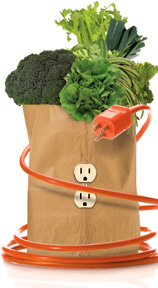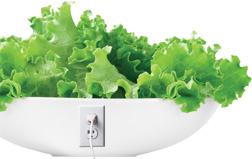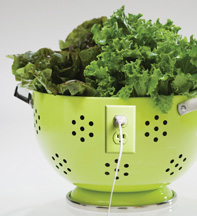While most people appreciate green vegetables as being healthy foods, their true power from a health perspective is generally not understood. A great example of this lack of understanding is apparent if I tell a patient to eat green vegetables in place of whole grains. Their typical response is, “If I do this, where will I get my fiber from?” In fact, there is no comparison between the fiber amounts and overall nutritional density of green vegetables versus whole grains. Perhaps the recent “whole-grain campaign” has turned people’s attention from the value of green vegetables and the nutritional power you can harness by eating them every day. Let’s take a look at a few quick comparisons between whole grains and green vegetables, focusing on two important nutrients: fiber and potassium (and bearing in mind that whole grains are also an important part of a healthy diet).

On a calorie by-calorie-basis, green vegetables contain substantially more fiber than whole grains. For example, 2 pieces of whole-wheat bread contain approximately 140 calories, only 4 grams of fiber, and 140 milligrams (mg) of potassium. In contrast, 2 cups of broccoli contain only 87 calories, but more than 9 grams of fiber and about 1,000 mg of potassium. And 5 cups of romaine lettuce (about the size of a large salad) provide only 80 calories, but 5 grams of fiber and 580 mg of potassium.
To understand the role green vegetables can play in your nutritional health, particularly when combined with other healthy foods such as fruit, consider that by eating 2 apples, 2 oranges, 2 cups of broccoli, and 5 cups of romaine lettuce on a daily basis, you would get approximately 450 calories, 28 grams of fiber, and more than 2,400 mg of potassium. The average American consumes only 15 grams of fiber per day; the typical recommendation is to get 25-30 grams per day (even that amount is likely too low).

Many diseases are associated with low fiber and low potassium intake. Diets low in fiber may underlie or exacerbate constipation, appendicitis, hemorrhoids, deep-vein thrombosis (a blood clot that forms in a vein deep within the body), varicose veins, diverticulitis (inflammation of an abnormal pouch in the intestinal wall), hiatal hernia, and gastroesophageal reflux. Fiber is thought to help prevent colon cancer, diabetes, and heart disease.
The general public rarely hears about importance of potassium in promoting health, so people rarely consider the need to eat potassium-rich foods – which coincidentally, are vegetables and fruits. (Animal protein and potatoes also provide substantial amounts of potassium, and by the way, whole and refined grains are generally among the worst dietary source of potassium. Research indicates that human beings need to take in about 7,000-11,000 mg of potassium per day, and this should come from diet, not supplements. However, the average American comes up well short of this number, consuming only about 2,500 mg per day or less. Numerous diseases are thought to be associated with such a low level of consumption,including high blood pressure, strokes, kidney stones, osteoporosis, gastrointestinal tract cancers, asthma, and insomnia.

Of course, besides containing high levels of fiber and potassium, green vegetables also contain an abundance of substances called phytochemicals, which are known to offer numerous disease-fighting benefits. The most well-known phytochemicals are bioflavonoids and carotenoids. In recent years, a substantial amount of research has been devoted to phytochemicals; the general conclusion from this research is that we need to ensure adequate intake of fruits and vegetables so we can reap the benefits of phytochemicals.
The important take-home message here is that whether you’re trying to lose weight or just stay in shape, green vegetables are filling, extremely nutritious and very low in calories. So plug into the power of green vegetables as part of a healthy diet.
| Nutritional Powerhouses Pound for pound, calorie for calorie, green vegetables pack a nutritional wallop – just look at the nutritional profile for relatively small portions of these six popular green foods, courtesy of the Food and Drug Administration. (Note: DV = recommended daily value based on 2,000 calorie daily diet)VegetableCaloriesFiberPotassiumVitamin A (% DV)Vitamin C (% DV)Calcium (% DV)Iron (% DV)Asparagus (5 spears)202 g230 mg10%15%2%2%Broccoli (1 medium stalk)453 g460 mg6%220%6%6%Bell pepper (1 medium)252 g220 mg4%190%2%4%Leaf lettuce (1.5 cups shredded)151 g170 mg130%6%2%4%Celery (2 medium stalks)152 g260 mg10%15%4%2%Cucumber (1/3 medium)101 g140 mg4%10%2%2% By Dr. David Seaman |